October 2025
In the United States, farming is a $624 billion industry and a cornerstone of our economy and national security. But it hasn’t always looked the way it does today.
Feeding the world: The triumph of chemical agriculture
The 20th century brought some of the most dramatic changes in agriculture since the dawn of agrarian societies, many of them sparked by wartime innovation. In the U.S. and Europe, advances in chemistry led to the development of ammonia for explosives and DDT to protect troops from insect-borne diseases. After WWII, the United States found itself with vast industrial capacity for producing these chemicals, and manufacturers quickly redirected their efforts to agriculture. Chemical companies, eager to find peacetime markets, promoted these “miracle” inputs to farmers, with government support accelerating adoption.
Between 1948 and 2015, annual fertilizer use soared from 2 million to 20 million tons, and farm output nearly tripled. Policy encouraged monocultures – planting a single crop across thousands of acres – to intentionally overproduce and cheaply export US crops through Eisenhower’s 1954 passage of the ‘Food for Peace’ program. Advances in hybrid seeds enabled farmers to specialize and scale. As consolidation increased, the share of income Americans spent on food dropped from 23% to just 10%, while the number of farms fell from 6.8 million to 1.88 million.
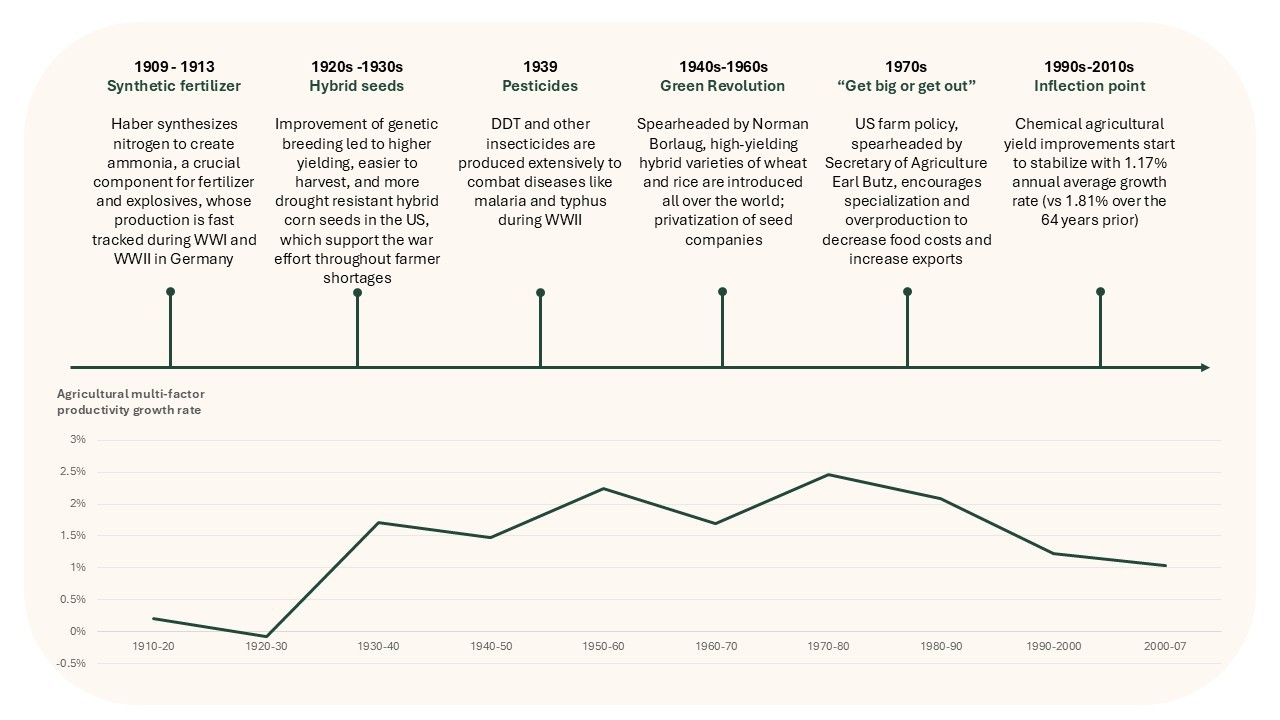
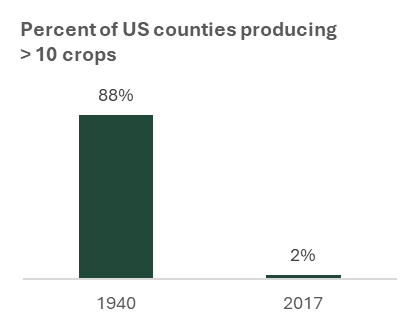
The cracks begin to show
As we celebrate the gains of chemical agriculture, it’s important to recognize the emerging cracks in the foundation. In prioritizing yield per acre, our current system has in turn neglected profit, ecosystem health, and species well-being.
First, the cost of maintaining high yields is rising. Fertilizer prices have surged, sometimes doubling in just a few years. Farmers now spend 65 times more on pesticides and twice as much on fertilizer and lime (in real dollars) compared to 75 years ago.
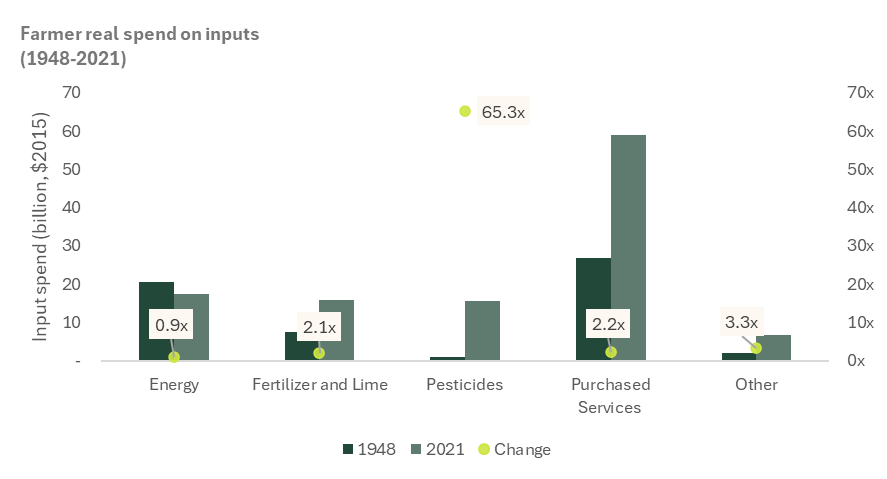
Despite these investments, farmer incomes have remained stubbornly flat, even as productivity has soared and the broader economy has grown. The benefits of innovation have not always translated into prosperity for those who work the land.
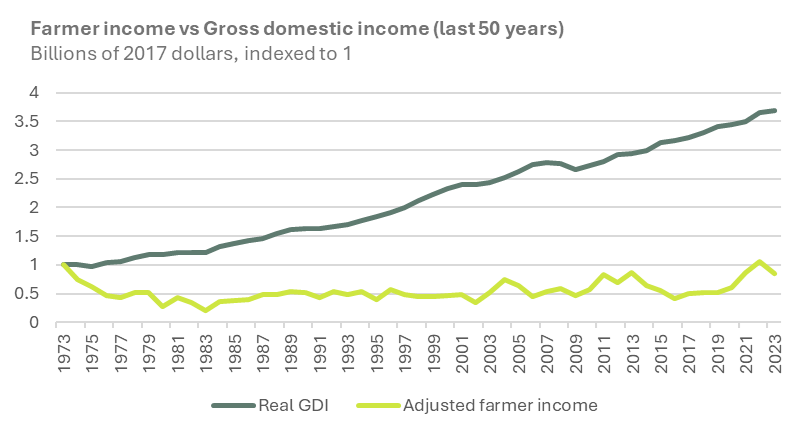
While chemical agriculture has triumphed in increasing production, it has strained natural resources like water and soil. Seventy percent of U.S. groundwater withdrawals go to irrigate crops, leading to severe depletion in regions like the Great Plains, where water tables have dropped more than 150 feet. As aquifers shrink, so do yields—threatening the long-term viability of farming communities.
Soil health is also under pressure. More than a third of Corn Belt farmland has lost its carbon-rich topsoil, reducing yields by 6% and costing Midwest farmers nearly $3 billion annually. Depleted soils struggle to retain water, making crops more vulnerable to drought and runoff.
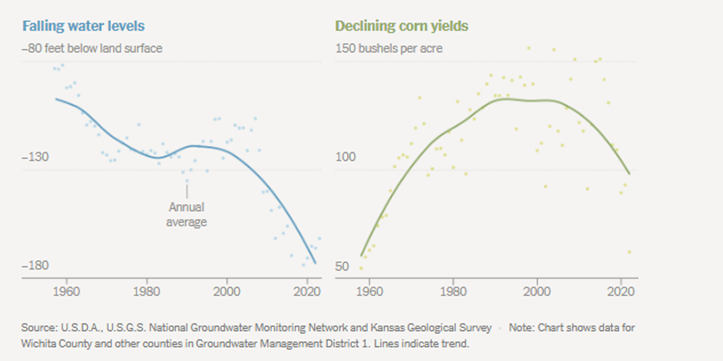
Humans and other species are also affected. Rachel Carson’s Silent Spring first alerted the public to the environmental toll of chemical agriculture. While regulation has helped, chemical inputs are still linked to biodiversity loss, increased cancer risk, and declining nutrient density in crops.
The next chapter: Biological agriculture and soil regeneration
Concerns about synthetic overuse, combined with advances in biology and plant science, are ushering in a new era: biological agriculture. Emerging research is proving just how much agricultural productivity is driven by healthy soils with robust mycorrhizal networks and microbial activity. This research has spurred development of biological inputs, which revitalize rather than strip soil ecosystems. Biologicals currently represent less than 5% of the agrochemical market but are growing faster than traditional inputs (7.2 vs 5.4% CAGR). This category encompasses biofertilizers, biostimulants, and biopesticides.
Regenerative agriculture offers a framework for farmers to effectively build soil health. Rooted in ancient and indigenous practices like cover cropping, crop rotations, and managed grazing, regenerative agriculture has emerged as a compelling modern farming system due to its ability to improve soil health while:
- Reducing or eliminating the use of chemical inputs (sometimes using biologicals as a short or long-term substitute)
- Maintaining or increasing crop yields
- Increasing crop resilience against severe weather AND
- Improving farm profitability.
What’s especially exciting is that farmers can, for the first time ever, measure and monitor the outcomes of these practices. Software innovations in farm management offer insights into crop ripening, pest threats, irrigation needs, and changes in underlying soil. Precision agriculture tools like drones and robotics reduce in-field labor costs, while on-farm sensors track key indicators like carbon sequestration. And analytical and generative AI close the loop by synthesizing these massive quantities of data to provide farmers with real-time insights about what’s happening both on their farm acres and with their businesses.
The era of chemical agriculture taught us how to produce food at extraordinary scale. Today’s challenge is more complex: how to continue meeting growing global demand while regenerating the soil that sustains our food system? We can’t rely solely on our grandparents’ farming practices to solve this. But when we marry modern innovation with regeneration, a sustainable and resilient food future becomes possible.
References
- Alston, J. M., & Pardey, P. G. (2020). The Drivers of U.S. Agricultural Productivity Growth. Federal Reserve Bank of Kansas City.
- Crossley, M. S., Burke, K. D., Schoville, S. D., Radeloff, V. C. (2021, January). Recent collapse of crop belts and declining diversity of US agriculture since 1840. Global Change Biology, 27(1), 151-164.
- Environmental Health Perspectives. (2025, June 10). Carcinogenic effects of long-term exposure from prenatal life to glyphosate and glyphosate-based herbicides in Sprague–Dawley rats.
- FRED. (2024, October 2). Net farm income, USDA (B1448C1A027NBEA). Federal Reserve Bank of St. Louis.
- FRED. (2025, September 25). Real gross domestic income (A261RX1Q020SBEA). Federal Reserve Bank of St. Louis.
- McKinsey & Company. (2024, June 10). From bytes to bushels: How gen AI can shape the future of agriculture.
- New York Times. (2023, August 28). America is using up its groundwater like there’s no tomorrow.
- Ramirez-Reyes, C., Sims, K. R. E., Potapov, P., & Radeloff, V. C. (2018). Payments for ecosystem services in Mexico reduce forest fragmentation. Ecological Applications.
- Tracy, J., Johnson, J., Konikow, L. F., Miller, G., Porter, D., Sheng, Z., & Sibray, S. (2019). Aquifer depletion and potential impacts on long-term irrigated agricultural productivity. USGS Issue Paper 63.
- UNIDO. (2021, June 16). New research shows food system is responsible for a third of global anthropogenic emissions. United Nations Industrial Development Organization.
- USDA ERS. (2025, January 5). Agricultural Productivity in the United States. Economic Research Service.
- Yale Environment 360. (2021, February 18). One-third of farmland in the U.S. Corn Belt has lost its topsoil.
